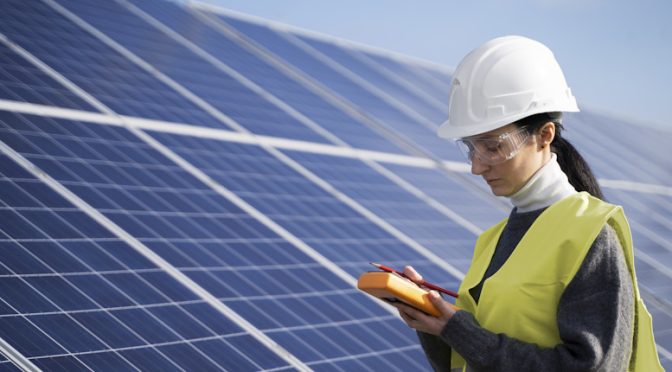Photovoltaic technology can be found everywhere, from rooftop solar panels on city buildings to large solar farms in rural areas. It can also be found in space, powering satellites and other craft, the longest-running application for solar panels.

Image Credit: Tom Wang/Shutterstock.com
In many parts of the world, solar panels provide the lowest-cost option for electricity. With more than 75% of the world’s population living within 40 degrees latitude of the equator, a region of rich solar resources, photovoltaic technology could become the world’s leading source of electricity by the middle of the century.
Innovative Applications of PV Technology
Although the technology has been around for decades, it often goes through refinement and innovation. In addition to greater efficiency and dependability, advances in solar power technology have translated into some unique applications.
Given the pressure to reduce carbon emissions created by power plants burning fossil fuels, innovative applications of photovoltaic technology could become everyday applications in the future as a sense of urgency grows around the technology.
Floating Solar Farms
Solar farms must be built on a large, clear area. If the designated area is full of vegetation, it has to be cleared. Excessive land use is one of the biggest criticisms of solar farms.
Floating solar farms aim to address this issue, and there is growing interest in this type of solar installation. Capacity has grown significantly recently, from 70 megawatts at peak power (MWp) in 2015 to 1300 MWp in 2020.
According to projections published by the BBC, the market for floating solar power will expand by more than 40% per year through 2030, with a valuation of more than $24 billion by 2031.
In addition to eliminating land use, installing solar panels on water also helps to keep them from overheating, which reduces their efficiency.
Floating solar farms also create shade in the water beneath them, lowering water temperature and evaporation to create a healthier ecosystem.
One of the more innovative floating solar farms is a pilot project located in the Netherlands. Double-sided panels floating on Oostvoornse Meer lake in southwest Holland can track the sun movement across the sky, increasing energy production by 35% compared to static panels.
Solar Roadways
Putting solar panels on roadways is an out-of-the-box solution; there have been several solar road installations in recent years.
In these installations, the solar road was made of three layers: a tempered glass top, a layer of solar cells, and a power delivery layer designed to connect to the grid.
The heaviest traffic is typically in the mornings and afternoons, while there is much lower traffic during midday when solar intensity is at its highest. The idea was implemented in Normandy France in 2016, with a 1-kilometer pilot project of solar roadway costing around $5 million.
In 2018, reports surfaced that the roadway was performing far below projections. One stretch of the roadway reportedly had to be replaced entirely. On top of that, fallen leaves on the road created problematic imbalances in solar absorption. Today, the pilot project has largely been abandoned.
Although solar roadways make a lot of sense, several financial and practical challenges need to be overcome for them to become a popular application of photovoltaic technology.
Solar Backpacks
Solar backpacks can produce enough power to power a small LED light or provide a modest charge to a small electronic device.
Most commercially available solar backpacks are designed for hikers who want to keep their devices charged. However, solar backpacks can also be a boon for children living in remote areas with limited access to electricity.
According to a report from the United Nations, solar backpacks in Botswana help students in remote areas to study at night with an LED light and charge their devices.
Photovoltaic Art and Design
Soltech Energy is a Swedish company installing beautifully designed building facades that are one part power generator, and one part art installation. One multicolored glass façade on a parking garage provides 300 charging posts for electric vehicles.
Smartflower is another innovative application that reimagines what commercial or residential solar panels are supposed to look like. Instead of a bank of rectangular panels, Smartflower is a flower-like solar panel with a rotating base and solar panels for petals. It can track the movement of the Sun and open or close its petals based on the amount of available sunlight.
Future Prospects and Challenges
Many recent advances in photovoltaic technology have focused on increasing efficiency, lowering costs, and improving dependability. However, there are also many unique applications of the technology that are helping to make the world a better place.
Going forward, the photovoltaic industry must continue to deal with challenges related to materials and the supply chain. Future research must consider these issues to better adapt next-generation devices to industry realities. One possible solution is the development of circular technologies and readily available materials.
References and Further Reading
Verlinden, P. et al. (2023). Photovoltaic device innovation for a solar future. Device. https://www.sciencedirect.com/science/article/pii/S2666998623000133?via%3Dihub
Shoemaker, S. (2023). Photovoltaic device innovation for a solar future. National Renewable Energy Laboratory. https://www.nrel.gov/news/program/2023/photovoltaic-device-innovation-poised-for-global-impact-on-the-future-energy-system.html
Beshilas, L. (2019). Floating solar photovoltaics could make a big splash in the USA. National Renewable Energy Laboratory. https://www.nrel.gov/state-local-tribal/blog/posts/floating-solar-photovoltaics-could-make-a-big-splash-in-the-usa.html
Kayawe, B. Solar backpacks lighting up Botswana school children’s studies. African Renewal – United Nations. https://www.un.org/africarenewal/magazine/march-2023/solar-backpacks-lighting-botswana-school-children%E2%80%99s-night-studies



